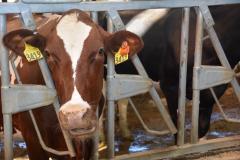Hoof Trimming of Dairy Cows
Hoof Trimming of Dairy Cows
 Hoof trimming plays a large role in the prevention of lameness in dairy cattle. The importance of preventing lameness is not only pertinent to the welfare of the cow, but it has economic implications as well. Lameness has been estimated to cost $185 per clinical case in first lactation cows and $333/case in mature cows (Ref. # 2). Hoof trimming renders the herd less susceptible to structural lameness as well as bacterial-caused lameness as a structurally sound hoof will be less susceptible to bacteria harbored in manure slurry. Understanding the right time to trim cows and if it was done properly are important factors in maintaining healthy hooves.
Hoof trimming plays a large role in the prevention of lameness in dairy cattle. The importance of preventing lameness is not only pertinent to the welfare of the cow, but it has economic implications as well. Lameness has been estimated to cost $185 per clinical case in first lactation cows and $333/case in mature cows (Ref. # 2). Hoof trimming renders the herd less susceptible to structural lameness as well as bacterial-caused lameness as a structurally sound hoof will be less susceptible to bacteria harbored in manure slurry. Understanding the right time to trim cows and if it was done properly are important factors in maintaining healthy hooves.
What is considered to be normal hoof growth?
The bovine hoof grows at a rate of approximately 2 inches per year. Weight bearing in the normal hoof occurs on the outer horny portion. When weight-bearing is shifted from this area, lameness becomes common (ref. #1).
When should I trim?
Twice yearly hoof trimming is typically appropriate; however the presence of infectious diseases can increase the need for hoof trimming as trimming may help alleviate some of the pain associated with these diseases (commonly digital dermatitis- also known as hairy heel warts). Disease-causing bacteria are often present in manure slurry. For hooves with overgrown toes, a heel with compromised structure will be more susceptible to bacterial invasion as it will be in contact with more slurry.
Semi-annual trimming serves as a mandatory maintenance trimming, while trimming after the onset of lameness serves as a form of corrective hoof trimming. Over-trimming however, can be destructive to the structural stability of the hoof as penetration of sensitive tissues below the horny wall can cause pain and render the cow lame. The normal hoof should be 3 inches long from the coronary band (the junction between skin and hoof) to the toe tip. The sole wall should be 0.25 inches thick. (ref. #4)
How can I implement hoof trimming on my farm?
One common practice is to hoof trim at dry-off and then again at 100 days in milk (Ref. #1). However, trimming twice yearly during any part of the year is acceptable. Record-keeping is key to maintaining proper trimming procedures and to ensure that every cow is trimmed.
How can I analyze my hoof trimmer?
The goal of hoof trimming is to provide a flat surface for weight-bearing. This flat surface redirects intensive weight-bearing on the sole and distributes it evenly across the horny surface. Effective hoof trimmers will keep this goal in mind. To further evaluate a hoof trimmer, it is important to question if the trimming was necessary in the first place. As previously mentioned, unnecessary hoof trimming can cause more harm than good. Cows who are not due for a trimming, should be evaluated and then returned to the herd (the aforementioned 3 inches/0.25 inches rule should be used when evaluating). Hooves of this length, should not be trimmed. Hoof walls that are a considerable amount longer or shorter than this value place stress on various muscles in the leg and can eventually lead to sole ulcers. Speaking to your hoof trimmer about how he determines when to trim can confirm that you both are in agreement on trimming criteria.
A higher toe angle (approximately 52 degrees) may result in more structural soundness as well as lowered susceptibility to infectious diseases, such as foot rot (Ref. #3). A hoof trimmer should consider this on farms that are dealing with a high incidence of infectious hoof diseases. The same study also concluded that differences in heel heights could contribute to the presence of ulcers. Unless special circumstances are present (for example, the practice of "blocking" or placing a block under one toe for the purpose of weight alleviation on the corresponding toe) hoof trimmers should equalize digit height. An ideal heel will be 1.5 inches from hairline to sole 5.
Hoof trimming is commonly an after-thought on many farms. Trimming is not completed in a timely manner and often trimmers are unqualified. Maintaining a trimming schedule as well as evaluating the quality of the hoof trimmer can decrease lameness and therefore increase milk production.
References:
1 Ishler, V. (2011). Prevention and Control of Foot Problems in Dairy Cows. Penn State.
2 Lang, D., L.M. Arnold, C.J. Stowe, R.J. Harmon, and J.M. Bewley. 2017. Estimating US dairy clinical disease costs with a stochastic simulation model. J. Dairy Sci. 100:1472.
3 Mohamadnia and Khaghani. (2013). Evaluation of Hooves morphometric parameters in different hoof trimming times in dairy cows. URL: https://www.ncbi.nlm.nih.gov/pmc/articles/PMC4279619/
4 Shearer, J. (n.d.). A Work Plan for Functional and Corrective Hoof Trimming. URL: http://www.hoofhealth.ca/Section4/article4_01.html
5 Zinpro. (2016). Dairy Cattle Hoof Trimming.
Authors: Haley B. Reichenbach and Donna M. Amaral-Phillips
